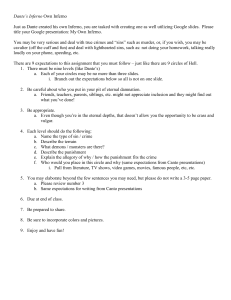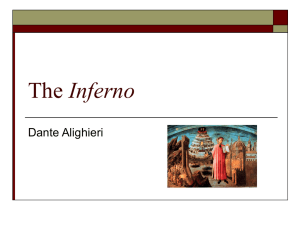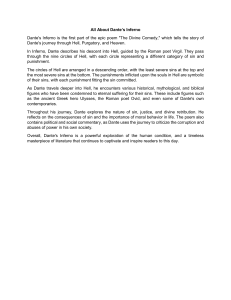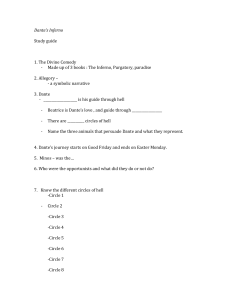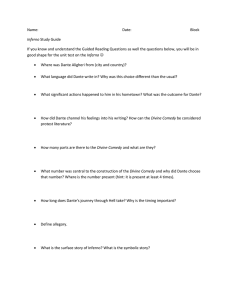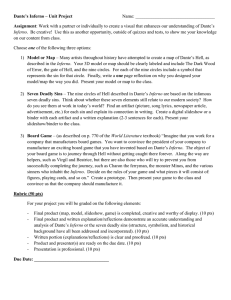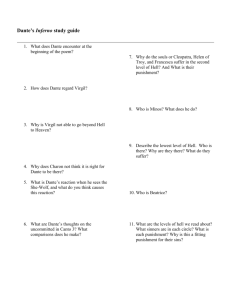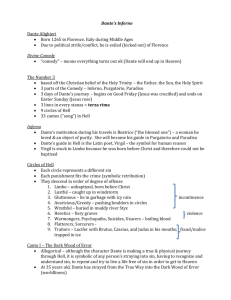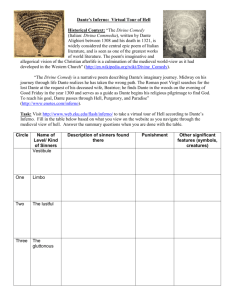File - Mrs. Walroth's Classroom
advertisement
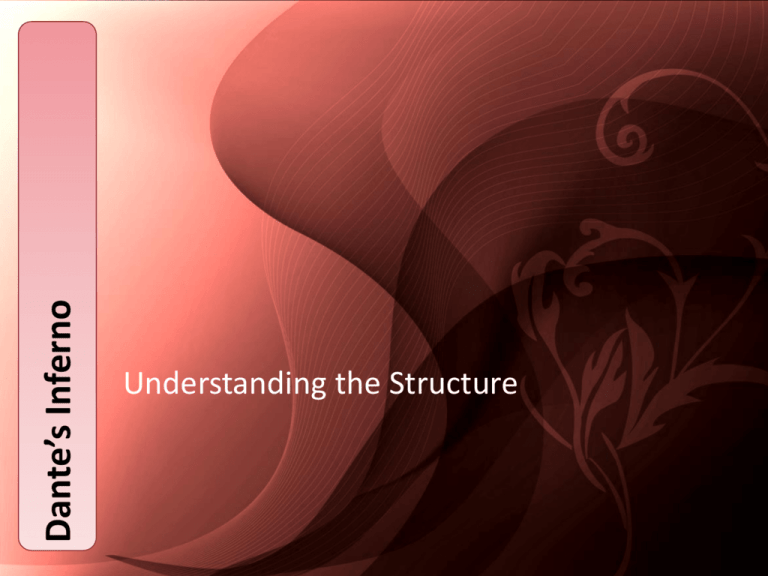
Dante’s Inferno Understanding the Structure The Divine Comedy • 14th Century Italian literature required that works be separated into two major groups – Tragedy (written in formal Italian and did not end well for the protagonist – Comedy (written in the local dialect and had a happy ending) • Since Dante used the common Florentine Tuscan to write a story that ended with the highest achievement of the ultimate level of heaven, it was, of course, a happy ending – He called his piece “The Comedy” (Giovanni Boccaccio later added “Divine” Structure • Composed of 14,233 lines divided into three canticas – Inferno (Hell) – Purgatorio (Purgatory) – Paradiso (Paradise) • Each consists of 33 cantos (with one additional canto to serve as an introduction) for a total number of 100 • The verse scheme used is “terza rima” – Hendecasyllabic (lines of eleven syllables) – Lines composing tercets (three lines of poetry making a stanza) according to the rhyme scheme aba, bcb, cdc, ded, … • The structure of the three realms follows a common numerical pattern of 9 plus 1 for a total of 10 – 9 circles of the Inferno, followed by Lucifer contained at its bottom – 9 rings of Mount Purgatory, followed by the Garden of Eden at the summit – 9 celestial bodies of Paradiso, followed by the Empyrean containing the essence of God The Inferno • Good Friday – Easter Sunday, 1300 – Dante is 35 years old, half of the biblical life expectancy of 70 • The story is an allegory, representing the Christian soul seeing sin for what it really is • Dante is lost in a dark wood (sin), is assailed by beasts (she-wolf, lion, leopard), and is unable to find the straight way (right way to salvation) • He is rescued by Virgil, and the two begin their journey into the underworld – Each sin’s punishment is a contrapasso, a symbolic retribution (their punishment matches their sin) • Within the 9 circles, 7 correspond to a specific moral scheme, subdividing itself into three subcategories, while 2 others of more particularity are added for a completion of 9 • The three beasts represent three types of sin (symbolic of the Trinity): – The incontinent (self-indulgent) – she-wolf • Circles 2-5: contained in Upper-Hell (lust, gluttony, avarice, and anger) – The violent – lion • Circle 7 – The malicious (fraud/betrayal) – leopard • Circles 8 & 9 (fraud and treachery) • Added to these are two unlike categories that are specifically spiritual: – Circle 1 – Limbo contains the virtuous pagans who were not sinful but were ignorant of Christ – Circle 6 – Contains the heretics who contradicted the doctrine and confused the spirit of Christ Structure of Hell • For the Medieval faithful, Hell was the place of turmoil, chaos, pain, despair, wretchedness, and a general bad time – They had a desire to classify and put order to things • Dante’s order was to place nine circles in the shape of a funnel or an inverted cone, ending at the center of the earth – Each circle descends from the sins of incontinence to the sins of fraud (which he despised the most)
